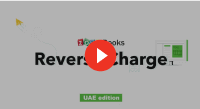Reverse Charge - UAE
What is reverse charge?
In a typical business, the supplier supplies goods and collects VAT on behalf of the customers, which is later paid to the government. Under reverse charge mechanism, the buyer or end customer pays the tax directly to the government.
The supplier does not have to pay VAT on import items, so the obligation of reporting a VAT transaction is shifted from the seller to the recipient. The recipient will have to record the VAT on purchases (input VAT) and the VAT on sales (output VAT) in their VAT return each quarter.
What is the need for reverse charge?
If the supplier does not have a business in the UAE, tracking their business transactions and ensuring VAT compliance becomes tedious for the FTA. Hence, recipients who are residents of the UAE are made to pay VAT on reverse charge basis. The reverse charge mechanism is mainly used for cross-border transactions. It relieves non-resident suppliers of the burden of registering and accounting for VAT in their buyers’ location.
When is reverse charge applicable?
Reverse charge is applicable in the following cases:
- Import of goods/services from other GCC and non-GCC countries. The supplier of these goods/services must be located in another country and they may or may not have a business in the UAE.
- Purchase of goods from a designated zone
- Supply of gold and diamonds
- Purchase of gold and diamonds for resale or further production/manufacture
- Supply of hydrocarbons for resale by a registered supplier to a registered recipient in the UAE
- Supply of crude/refined oil by a registered supplier to a registered recipient in the UAE
- Supply of processed/unprocessed natural gas by a registered supplier to a registered recipient in the UAE
- Production and distribution of any form of energy supplied by a registered supplier to a registered recipient in the UAE
Note: Reverse charge mechanism is not applicable on the export of gold and diamonds, supply of investment precious metals (platinum or gold with purity greater than 99% that is tradable in global markets), and export of products where the main component is gold or diamonds.
How does reverse charge mechanism work?
To understand the mechanism better, let’s look at an example using an imported service:
Mr. Abdul is a VAT-registered person in the UAE, but he uses the services of a bookkeeper named Sam, who is based in Italy. As Sam is not registered in the UAE, he does not have to file any UAE returns or pay UAE tax. Because Mr. Abdul has acquired services from a non-UAE-based supplier, he will have to record the reverse charge on his relevant VAT return. In this example, because the recipient accounts for the VAT under the reverse charge mechanism, the place of supply for VAT purposes is the UAE.
If I am a recipient involved in a reverse charge transaction, what should I do?
You should calculate the amount of tax to be paid to the government, self-account the VAT amount as output tax during the purchase and then declare it in your VAT return. You may claim input credit if possible. Make sure you maintain the necessary documents like invoices for future reference.
What are the requirements for the reverse charge mechanism?
- The receiver of the goods or services must be registered for VAT.
- Every registered business owner must keep proper records of their supplies that incur reverse charge.
- Invoices, receipt vouchers, and refund vouchers should all specify whether the tax payable for that particular transaction is through reverse charge

 Reverse Charge for UAE Edition
Reverse Charge for UAE Edition